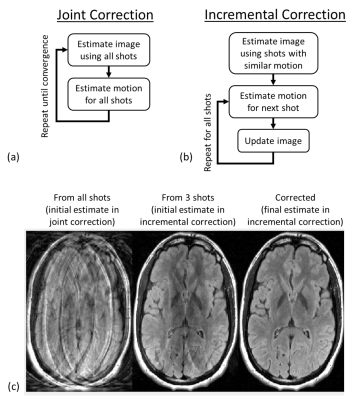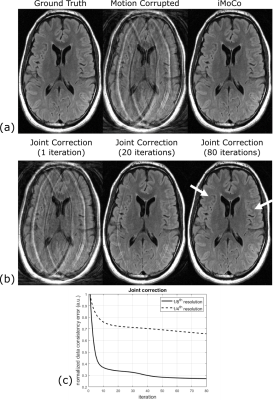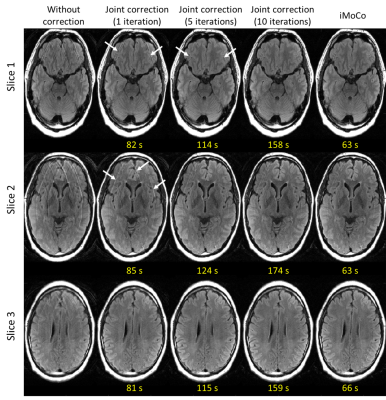1368
Incremental motion correction (iMoCo) for fast retrospective image reconstruction with reduced motion artifacts1Magnetic Resonance, Canon Medical Research USA, Inc., Mayfield Village, OH, United States
Synopsis
Retrospective rigid-body motion correction methods often alternate between updating the estimate of the motion parameters and updating the image. The alternating minimization reconstruction is time-consuming, which is problematic in the clinical setting. We propose a new method for retrospective rigid-body motion correction that makes use of the insight that many shots of the imaging data have similar motion values, and therefore a reference image can be created from the imaging data itself. By leveraging this insight, this method is able to quickly reconstruct motion-corrected images without requiring large amounts of ML training data and without requiring an additional scout scan.
Introduction
Retrospective rigid-body motion correction methods aim to reconstruct an image without motion artifacts from data that were acquired during patient motion. These techniques often alternate between updating the motion parameters and updating the image using the model that is presented in Equation 1, where x is the motion-free image, T is a matrix of motion parameters for each shot, S denotes the coil sensitivity maps, F is the Fourier transform, and A is a matrix that selects the acquired k-space samples for each shot1.k = AFSTx + N(0,σ2) [Eq. 1]
The alternating minimization reconstruction is time-consuming. This is especially problematic in the clinical setting.
The NAMER method has demonstrated a reduction in reconstruction time2. NAMER uses a CNN to remove motion artifacts from the image estimate at each alternating minimization iteration. Haskell et al. demonstrated that using the CNN reduces the reconstruction time by allowing faster convergence of the estimates of the motion parameters. However, the CNN requires large amount of training data in order to perform robustly across different types of motion parameters.
The SAME method3 was recently developed to also reduce reconstruction time for retrospective rigid-body motion correction. SAME acquires a reference scout image for the estimation of the motion parameters. A benefit of SAME is that alternating minimizations are not necessary because the reference image is formed from the scout scan. However, SAME increases total scan time because a scout image must be acquired. Further, the scout image must be motion-free.
We propose a new method termed incremental motion correction (iMoCo) for retrospective rigid-body motion correction. iMoCo makes use of the insight that many shots of the imaging data have similar motion, and therefore a reference image can be created from a subset of the imaging data itself. By leveraging this insight, iMoCo is able to quickly reconstruct motion-corrected images without requiring large amounts of data for ML training and without requiring an additional scout scan. We demonstrate the performance of iMoCo using both simulated and acquired motion-corrupted images.
Methods
Figure 1 demonstrates the iMoCo method for a 2D FSE FLAIR acquisition with six shots. An initial reference image is formed from a subset of the shots that have similar motion values. Subsequently, motion estimation for the remaining shots is performed sequentially using the reference image. For example, for a six shot FLAIR acquisition, an initial reference image is created using data from three shots that have similar motion values. Then, the motion values for the fourth shot are estimated, and the reference image is updated to include data from this motion-corrected shot. This cycle repeats until motion for all shots has been estimated, and the motion-corrected shot data are used to improve the reference image estimate.To demonstrate this method, data were acquired on a Vantage Galan 3T MR system (Canon Medical Systems Corporation, Nasu, Japan) using a 16-channel head coil. FLAIR acquisition parameters included: FOV=24x24cm2, matrix size=288x256, slice thickness=4mm, TR/TE/TI=11000/120/2850ms, ETL=29, 6 shots. Both motion-free and motion-corrupted datasets were acquired. The motion-free dataset was acquired to retrospectively study the performance of iMoCo. The motion-corrupted dataset was acquired to prospectively assess the performance of iMoCo. The subject was asked to rotate their head once about the head-foot axis during the scan.
Simulated motion was added to the motion-free dataset using the model presented in Equation 1. Translation and rotational motion were added to two shots of the six-shot dataset. The synthesized motion-corrupted dataset was reconstructed using the joint motion correction1 and using iMoCo. The acquired motion-corrupted dataset was reconstructed using joint motion correction and using iMoCo. A multi-resolution reconstruction strategy was used in both joint correction and iMoCo1. Shots for the initial reference image were selected by performing an initial low-resolution estimate of the motion values. Offline reconstruction was done in Matlab on a computer with Intel i7 processor at 2.4 GHz using 8 GB RAM. Reconstruction time was calculated using ‘tic’ and ‘toc’ commands in Matlab.
Results
Figure 2 shows the results of the joint motion correction and the incremental motion correction (iMoCo) for the synthesized motion-corrupted dataset. Using joint correction, motion artifacts remained after 80 iterations of the alternating minimization (white arrows). Using iMoCo, the motion-free image is recovered. Figure 3 shows the results of the joint motion correction and the incremental motion correction (iMoCo) for three slices of the acquired motion-corrupted dataset. Using joint correction, 5-10 alternating minimization iterations were needed to recover the motion-free image. The total reconstruction time was between 110-175 seconds for each slice. For iMoCo, the motion-free image was recovered. The total reconstruction time was between 60-70 seconds for each slice.Discussion
iMoCo is a new method that reduces the reconstruction time for retrospective rigid-body motion correction. We have demonstrated that iMoCo reduces the reconstruction time by about a factor of 2 while still recovering motion-corrected images. iMoCo uses a subset of the imaging data itself to generate a reference image. Therefore, iMoCo does not require training data and it does not require a separate scout scan. Future work may involve parallelizing the motion estimation of each shot to further reduce reconstruction time.Acknowledgements
No acknowledgement found.References
1. Cordero-Grande L, Teixeira R, Hughes EJ et al. Sensitivity encoding for aligned multishot magnetic resonance reconstruction. IEEE Trans Comput Imaging. 2016;2:266–280.
2. Haskell MW, Cauley SF, Bilgic B, et al. Network accelerated motion estimation and reduction (NAMER): convolutional neural network guided retrospective motion correction using a separable motion model. Magn Reson Med. 2019;82:1452-1461.
3. Polak D, Cauley S, Bilgic B, et al. Scout acquisition enables rapid motion estimation (SAME) for retrospective motion mitigation. ISMRM virtual conference and exhibition 2020, p. 0463.
Figures


